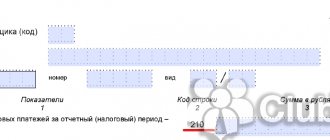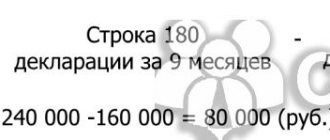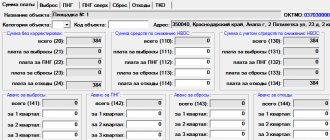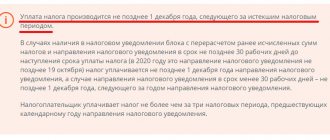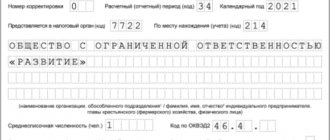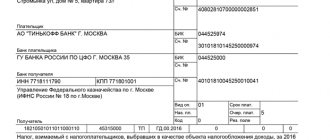What is non-operating income?
According to Art. 172 of the Tax Code of the Russian Federation when purchasing goods (works, services), property rights under contracts, the obligation to pay for which is provided in rubles in an amount equivalent to a certain amount in foreign currency, or in conventional monetary units, tax deductions for subsequent payment of these goods (works, services), property rights are not adjusted. The difference in the amount of tax that arises for the buyer upon subsequent payment is taken into account as part of non-operating income.
In accordance with Article 250 of the Tax Code of the Russian Federation, non-operating income is the following income:
| Income | A comment |
| From equity participation in other organizations | With the exception of income allocated to pay for additional shares (shares) placed among the shareholders (participants) of the organization |
| In the form of a positive (negative) exchange rate difference resulting from deviation of the sale (purchase) rate of foreign currency from the official rate established by the Central Bank of the Russian Federation | On the date of transfer of ownership of foreign currency |
| In the form of fines, penalties and (or) other sanctions recognized by the debtor or payable by the debtor on the basis of a court decision that has entered into legal force | For violation of contractual obligations, as well as amounts of compensation for losses or damages |
| From leasing property (including land plots) (subleasing) | If such income is not determined by the taxpayer |
| From granting for use rights to the results of intellectual activity and rights to equivalent means of individualization | If such income is not determined by the taxpayer |
| In the form of interest received under loan agreements, credit agreements, bank accounts, bank deposits, as well as on securities and other debt obligations | |
| In the form of amounts of restored reserves, the costs of the formation of which were accepted as part of expenses | |
| In the form of gratuitously received property (work, services) or property rights | When receiving property (work, services) free of charge, income is assessed based on market prices |
| In the form of income distributed in favor of the taxpayer with his participation in a simple partnership | |
| In the form of income from previous years identified in the reporting (tax) period | |
| In the form of a positive exchange rate difference | With the exception of positive exchange rate differences arising from the revaluation of advances issued (received). For the purposes of this chapter, a positive exchange rate difference is an exchange rate difference that arises when revaluing property in the form of foreign currency assets (except for securities denominated in foreign currency) and claims, the value of which is expressed in foreign currency, or when devaluing liabilities, the value of which is expressed in foreign currency. currency. |
| In the form of fixed assets and intangible assets received free of charge in accordance with international treaties of the Russian Federation or with the legislation of the Russian Federation by nuclear power plants to improve their safety, used for non-production purposes | |
| In the form of the cost of received materials or other property during dismantling or disassembly during the liquidation of decommissioned fixed assets | |
| In the form of property (including funds) used for other purposes than for its intended purpose, works, services received as part of charitable activities (including in the form of charitable assistance, donations), targeted income, targeted financing, with the exception of budgetary funds | |
| In the form of funds used for purposes other than their intended purpose by enterprises and organizations that include especially radiation-hazardous and nuclear-hazardous production and facilities, funds intended for the formation of reserves to ensure the safety of these production and facilities at all stages of their life cycle and development | |
| In the form of amounts by which in the reporting (tax) period there was a decrease in the authorized (share) capital (fund) of the organization, if such a decrease was carried out with a simultaneous refusal to return the cost of the corresponding part of the contributions (contributions) to the shareholders (participants) of the organization | |
| In the form of refund amounts from a non-profit organization of previously paid contributions (contributions) in the event | If such contributions (contributions) were previously taken into account as expenses when forming the tax base |
| In the form of amounts of accounts payable (liabilities to creditors), written off due to the expiration of the statute of limitations or for other reasons | Does not apply to the write-off by a mortgage agent of accounts payable in the form of obligations to the owners of mortgage-backed bonds, as well as to the write-off by a specialized company of accounts payable in the form of obligations to the owners of bonds issued by it |
| In the form of income received from transactions with derivative financial instruments | |
| In the form of the value of surplus inventories and other property that are identified as a result of inventory | |
| In the form of the cost of media products and book products, subject to replacement upon return or write-off of such products | |
| In the form of adjustments to the taxpayer’s profit due to the application of methods for determining for tax purposes the conformity of prices used in transactions with market prices (profitability) | |
| In the form of the cash equivalent of real estate and (or) securities transferred to replenish the endowment capital returned to the donor or his legal successors | The cost at which the securities were taken into account in the tax accounting of the donor on the date of their transfer to replenish the target capital of a non-profit organization |
| In the form of the difference between the amount of tax deductions from the excise tax amounts | |
| As profit of a controlled foreign company |
“Import” VAT is reflected in accounting without the right to deduction
When applying the simplified tax system without paying VAT, obligations to pay VAT arise, for example, when importing goods, purchasing goods (work, services) from non-residents.
Where do the VAT amounts paid by organizations and individual entrepreneurs belong?
Organizations and individual entrepreneurs using the simplified tax system without VAT do not calculate or pay VAT in relation to turnover on the sale of objects in the territory of the Republic of Belarus (subclause 1.1 clause 1 of article 115, subclause 1.1.2 clause 1 of article 326 of the Tax Code [1]).
At the same time, they calculate and pay VAT:
– when importing goods into the territory of Belarus (paragraph 2, paragraph 2, article 326, subparagraph 1.2, paragraph 1, article 115 of the Tax Code);
– when purchasing objects on the territory of the republic from foreign organizations that are not registered with the tax authorities of the Republic of Belarus (Article 114, paragraph 3, paragraph 2, Article 326 of the Tax Code). The obligation to calculate and pay VAT arises if the place of sale of the acquired objects is recognized as the territory of the Republic of Belarus (Articles 116, 117 of the Tax Code).
During the period of application of the simplified tax system without paying VAT, the amounts of VAT presented when purchasing objects or paid when importing goods into the territory of the Republic of Belarus, as well as paid when purchasing objects on its territory from foreign organizations that are not registered with the Belarusian tax authorities, are considered organizations and individual entrepreneurs to increase the cost of acquired objects (clause 14 of article 132 of the Tax Code).
Income from the sale of currency and taxation under the simplified tax system
Is the positive difference when selling currency (deviation from the National Bank exchange rate) included in non-operating income for tax purposes under the simplified tax system?
Non-operating income includes income that is included in non-operating income in accordance with the Tax Code (part one of paragraph 8, part one of paragraph 10 of Article 328 of the Tax Code):
– for organizations – when calculating income tax, except for those specified in subparagraph. 3.1–3.3, 3.18, 3.20, 3.30–3.32 clause 3 art. 174 NK;
– for individual entrepreneurs – when calculating income tax from individuals, except for those specified in subparagraph. 9.3 and 9.6 clause 9 art. 205 NK.
The composition of non-operating income is established for calculation purposes:
– income tax – in clause 3 of Art. 174 NK;
– income tax – in clause 9 of Art. 205 NK.
Non-operating income for organizations using the simplified tax system includes, incl. income from the sale of foreign currency in the amount of the positive difference generated as a result of deviation of the foreign currency sale rate from the official rate established by the National Bank of the Republic of Belarus on the date of sale (subclause 3.26, clause 3, article 174 of the Tax Code).
Non-operating income for individual entrepreneurs using the simplified tax system also includes income from the sale of foreign currency in the amount of the positive difference formed as a result of deviation of the foreign currency sale rate from the official rate established by the National Bank of the Republic of Belarus on the date of sale (subclause 9.4, clause 9, article 205 NK).
Consequently, such income is included in non-operating income for both organizations and individual entrepreneurs.
Exchange rate and amount differences when taxing the simplified tax system
How are exchange rate and amount differences taken into account for tax purposes under the simplified tax system?
Non-operating income includes income that is included in non-operating income in accordance with the Tax Code (part one of paragraph 8, part one of paragraph 10 of Article 328 of the Tax Code):
– for organizations – when calculating income tax, except for those specified in subparagraph. 3.1–3.3, 3.18, 3.20, 3.30–3.32 clause 3 art. 174 NK;
– for individual entrepreneurs – when calculating income tax from individuals, except for those specified in subparagraph. 9.3 and 9.6 clause 9 art. 205 NK.
Exceptions include:
– for organizations – exchange rate differences arising when recalculating the value of assets and liabilities expressed in foreign currency and (or) Belarusian rubles in an amount equivalent to a certain amount in foreign currency, determined in the manner established by the legislation of the Republic of Belarus (except for those arising from recipients of foreign gratuitous assistance when converting into Belarusian rubles the value of assets and liabilities associated with the receipt and use of foreign gratuitous assistance, expressed in foreign currency, with the intended use of foreign gratuitous assistance) (subclause 3.20, clause 3, article 174 of the Tax Code);
– for individual entrepreneurs – positive differences arising when revaluing property (cash in foreign currency accounts in banks, at cash desks) in foreign currency when the National Bank of the Republic of Belarus changes foreign currency rates on the date of the transaction (subclause 9.3, clause 9, article 205 of the Tax Code) .
If the amount of liabilities is expressed not in foreign currency, but in Belarusian rubles is equivalent to an amount in foreign currency or in foreign currency is equivalent to an amount in another foreign currency, then non-operating income includes the positive difference that arises when paying off receivables or payables (the so-called total difference) (subparagraph 3.21, paragraph 3, article 174, subparagraph 9.12, paragraph 9, article 205 of the Tax Code).
Thus, exchange rate differences resulting from the recalculation of assets and liabilities expressed in foreign currency are not taken into account when calculating tax under the simplified tax system, and the so-called amount differences must be included in non-operating income and taxed under the simplified tax system |*|.
* Nuances of recording revenue in equivalent for calculating tax under the simplified tax system in 2022.
The procedure for recording revenue in KUDiR by the committent
The principal - a Belarusian organization applies the simplified tax system without paying VAT, keeps records in the book of income and expenses of organizations and individual entrepreneurs using the simplified taxation system (KUDiR).
How to correctly reflect revenue in KUDiR?
Taking into account the peculiarities of the activities of individual organizations and individual entrepreneurs, the revenue from the sale of goods for the purpose of determining the tax base and gross proceeds of tax under the simplified tax system when selling goods on the basis of commission agreements with the principal includes the cost (price) at which the goods were sold (subclause 5.2 clause 5 Article 328 of the Tax Code).
If the committing organization maintains KUDiR, revenue is reflected (part one of paragraph 15 of Article 328 of the Tax Code):
– on the date of payment for goods that were shipped before or on the day of payment;
– on the date of shipment of goods for which payment was received before this date.
In this case, the date of shipment of goods is the date of their shipment by the commission agent to the buyer. There is no other option for organizations on the simplified tax system with the maintenance of KUDiR (part eight, paragraph 15, article 328 of the Tax Code).
The date of payment for goods is the date the buyer credits funds to the account (part four, clause 15, article 328 of the Tax Code):
– principal – if the contract stipulates that funds for goods sold by the commission agent are credited to the principal’s account;
– commission agent – otherwise.
Sale of currency in circulation under VAT and revenue under the simplified tax system
The organization provides services for export and applies the simplified tax system with payment of VAT. Currency is transferred to the current account, and when it is sold, a positive difference is formed between the bank’s selling rate and the National Bank rate set on that day.
Is this income subject to tax under the simplified tax system and VAT?
The object of taxation under the simplified tax system is gross revenue (Article 325 of the Tax Code).
The tax base under the simplified tax system is determined as the monetary expression of gross revenue. Gross revenue is defined as an amount consisting of revenue from the sale of goods (work, services), property rights and non-sale income (clause 1 of Article 328 of the Tax Code).
For organizations, non-operating income includes income included in accordance with the Tax Code as part of non-operating income when calculating profit tax, except for those specified in subparagraph. 3.1–3.3, 3.18, 3.20, 3.30–3.32 art. 174 Tax Code (part one of clause 8, part one of clause 10 of article 328 of the Tax Code).
Non-operating income includes income from the sale of foreign currency in the amount of the positive difference generated as a result of deviation of the foreign currency sale rate from the official rate established by the National Bank on the date of sale (subclause 3.26, clause 3, article 174 of the Tax Code).
Thus, this income is classified as non-operating income and is taxed under the simplified tax system at generally established rates, i.e. at rates of 5% - when applying the simplified tax system without paying VAT, at a rate of 3% - when applying the simplified tax system with payment of VAT |*|.
* Simplified taxation system - conditions of application, restrictions and transition
The object of VAT taxation is the turnover of sales of goods, works, services, property rights (clause 1 of Article 115 of the Tax Code).
Goods do not include money and property rights (subclause 7.1, clause 7, article 115 of the Tax Code).
Consequently, for the purposes of calculating VAT, non-operating income generated from the sale of currency is not subject to taxation.
What does non-operating income look like in the income tax return?
The tax return form was approved by Order of the Federal Tax Service dated October 19, 2016 No. ММВ-7-3/ [email protected] “On approval of the tax return form for corporate income tax, the procedure for filling it out, as well as the format for submitting the tax return for profit of organizations in electronic form”, where in Appendix No. 1 (to Sheet 02) the following information must be indicated:
| Line | Explanation |
| 100 | The total amount of non-operating income for the tax period |
| 101-106 | Decoding of non-operating income for the tax period |
The total amount of non-operating income for the tax period indicated in line 100 is duplicated in line 020 of Sheet 02, where it is necessary to calculate the tax.
Accrual of interest on deposits and issued loans - non-operating income
Every entrepreneur, when organizing his own business, strives for a single goal - to make a profit. But for this you need to generate some income. Income can be received from the sale of products of own production, goods previously purchased for the purpose of resale, as well as from the performance of work and the provision of services. This concerns the main activity of an economic entity.
But there is another type of income. Thus, an individual entrepreneur or organization can open a deposit account with a banking institution in order to receive additional funds in the form of accrued interest on the balance of this account. Additional income can also be obtained by issuing funds to other economic entities and charging the borrower interest for use. Accrued interest receivable on both deposits and loans issued will constitute so-called non-operating income, which must subsequently be taken into account when calculating income tax.
In the income tax return, the amounts of accrued interest receivable will be included in line 100 of Appendix 1 to Sheet 02.
What about the VAT return? Are the specified non-operating incomes included in it?
From the report for the 4th quarter of 2022, it is necessary to use a new VAT declaration form, approved. by order of the Federal Tax Service dated August 19, 2020 No. ED-7-3/ [email protected]
How to correctly enter non-operating income into the VAT return?
The tax return form was approved by Order of the Tax Service dated October 29, 2014 No. ММВ-7-3/ [email protected] “On approval of the tax return form for value added tax, the procedure for filling it out, as well as the format for submitting the tax return for value added tax value in electronic form”, which does not provide for entering data on non-operating income. Basically, the tax legislation of the Russian Federation does not provide for the imposition of VAT on non-operating income, but if non-operating income is income in the form of interest on a loan, then this amount must be included in Section 7 of the tax return for value added tax. However, this amount will not be the tax base.
Reflection of interest on loans issued in the VAT return
The situation is somewhat different with the interest that the lender accrues to the borrower when issuing loans in the form of cash.
According to sub. 15 clause 3 art. 149 of the Tax Code of the Russian Federation, the accrual of these interests is an operation exempt from VAT. It is for such operations that the tax report provides for Section 7, which contains four columns filled in as follows:
- column 1 - code 1010292 is given, designated “Loan operations in cash and securities, including interest on them...”;
- column 2 - the amount of accrued interest receivable is recorded;
- Columns 3 and 4 are crossed out.
According to paragraph 3 of Art. 169 of the Tax Code of the Russian Federation, the lender does not need to issue invoices for the amount of interest accrued under loan agreements.
When simultaneously carrying out transactions that are subject to VAT and exempt from this tax, the taxpayer must maintain separate accounting, the principles of which must be outlined in the accounting policy.
Difference in non-operating income in declarations
Non-operating income in the income tax return will differ from the value added tax return:
| Non-operating income | Income tax return | Value added tax declaration |
| In the form of gratuitously received property (work, services) or property rights | Non-operating income | Not included in the declaration |
| In the form of fines, penalties and (or) other sanctions recognized by the debtor or payable by the debtor on the basis of a court decision that has entered into legal force | ||
| In the form of amounts of accounts payable (liabilities to creditors), written off due to the expiration of the statute of limitations or for other reasons | ||
| In the form of interest received under loan agreements, credit agreements, bank accounts, bank deposits, as well as on securities and other debt obligations | ||
| In the form of a positive (negative) exchange rate difference resulting from deviation of the sale (purchase) rate of foreign currency from the official rate established by the Central Bank of the Russian Federation | ||
| In the form of amounts of restored reserves, the costs of the formation of which were accepted as part of expenses | ||
| In the form of the cost of received materials or other property during dismantling or disassembly during the liquidation of decommissioned fixed assets |
How do non-operating incomes fall into the VAT return?
If we turn to the VAT return (its form was approved by order of the Federal Tax Service dated October 29, 2014 No. ММВ-7-3/ [email protected] as amended by order dated December 20, 2016 No. ММВ-7-3/ [email protected] ), then we will not see a line directly related to non-operating income. Quite often, non-operating income is not subject to VAT and is not included in the relevant tax reporting. But not always.
One such example is the amount of accrued interest receivable from loans. It is one of the types of non-operating income and must be included in section 7 of the VAT return during the interest calculation period. The specified amount does not form a tax base for the tax (subclause 15, clause 3, article 149 of the Tax Code of the Russian Federation).
NOTE! Section 7 serves to reflect data on transactions that are not subject to taxation, and on transactions where the place of sale is not Russian territory. In addition, information about received advance payment for products, the production of which, due to technological features, takes more than 6 months, is entered here.
Income from the rental of property is also non-operating, except in cases where the provision of property for rent is defined in the charter as one of the main areas of business. Renting out property is not an operation exempt from VAT, so the amount for it will have to go to line 010 of section 3 and form the basis for calculating the tax.
Questions and answers
- How can we take into account the return of previously paid contributions from a non-profit organization as non-operating income?
Answer: According to Art. 250 of the Tax Code of the Russian Federation, such contributions (contributions) must be taken into account as expenses when forming the tax base.
- We dismantle expensive equipment in order to liquidate it and remove it from fixed assets. Can we consider the income received as a result of dismantling as non-operating?
Answer: In accordance with Art. 250 of the Tax Code of the Russian Federation, non-operating income is recognized as income received in the form of the cost of received materials or other property during dismantling or disassembly during the liquidation of fixed assets being decommissioned. Thus, you can treat the resulting income as non-operating income.
Non-operating income and expenses in the VAT return
2 tbsp. 56 Tax Code of the Russian Federation. However, keep in mind that tax authorities often request these documents as part of desk audits of VAT returns. The fact is that they are being cunning and equate the opportunity not to charge VAT when providing services, the place of sale of which is not the territory of the Russian Federation, to the use of benefits. This is done in order to seem to legally demand documents from you within the framework of the Cameroon Keep. 6 tbsp. 88
Tax Code of the Russian Federation. But if, at the request of the tax authorities, you do not provide documents confirming the legality of non-assessment of VAT, then, based on the results of a desk audit, they may charge you additional VAT and penalties. About what is considered a tax benefit and when it matters, read: 2012, No. 7, p.
79 Of course, if you don’t want to quarrel with your Federal Tax Service, you can submit all the documents requested during the chamber meeting.
- Warranty repairs: we calculate the VAT proportion and fill out the declaration, No. 24
- VAT exemption received: should I submit a declaration?, No. 20
- How tax authorities cameralize section 7 of the VAT return, No. 13
- Section 7 of the VAT return: what to write down and where, No. 12
- Exemption from VAT retroactively upon leaving the special regime, No. 4
- Exchange of experience: VAT deduction for taxable and non-taxable transactions, No. 3
- 2013
- Taxable + non-taxable: divide and restore VAT, No. 20
- For special regime - with VAT exemption: there are features, No. 20
- We purchase OS in parts for taxable and non-taxable transactions: how to divide VAT, No. 8
- Calculation of revenue for VAT exemption purposes: what to include and what not to include, No. 7
- Quarter without shipments: how to divide VAT by taxable and non-taxable activities, No. 1
2012


